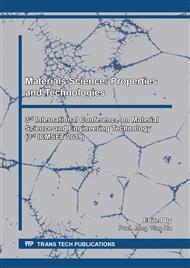[1]
S. L. Bahna, Cow's milk allergy versus cow milk intolerance, Ann. Allergy Asthma Immunol. 89(6) (2002) 56-60.
DOI: 10.1016/s1081-1206(10)62124-2
Google Scholar
[2]
P. Bertron, N. D. Barnard, M. Mills, Racial bias in federal nutrition policy, Part I: The public health implications of variations in lactase persistence, J. Natl. Med. Assoc. 91(3) (1999) 151-157.
Google Scholar
[3]
P. Ridefelt, L. D. Kansson, Lactose intolerance: Lactose tolerance test versus genotyping, Scand. J. Gastroenterol. 40(7) (2005) 822-826.
DOI: 10.1080/00365520510015764
Google Scholar
[4]
Y. Deng, B. Misselwitz, N. Dai, M. Fox, Lactose Intolerance in Adults: Biological Mechanism and Dietary Management, Nutrients, 7(9) (2015) 8020-8035.
DOI: 10.3390/nu7095380
Google Scholar
[5]
S. K. Vanga, V. Raghavan, How well do plant based alternatives fare nutritionally compared to cow's milk?, J. Food Sci. Technol. 55(1) (2018) 10-20.
DOI: 10.1007/s13197-017-2915-y
Google Scholar
[6]
S. M. A. Razavi, E. Milani, Some physical properties of the watermelon seeds, Afr. J. Agric. Res. 1(3) (2006) 65-69.
Google Scholar
[7]
H. Kaymak, The relationships between seed fatty acids profile and seed germination in cucurbit species, Žemdirbystė=Agric. 99(3) (2012) 299-304.
Google Scholar
[8]
S. Azhari, Y. S. Xu, Q. X. Jiang, W. S. Xia, Physicochemical properties and chemical composition of Seinat (Cucumis melo var. tibish) seed oil and its antioxidant activity, Grasas y aceites, 65(1) (2014).
DOI: 10.3989/gya.074913
Google Scholar
[9]
T. J. Jacks, T. P. Hensarling, L. Y. Yatsu, Cucurbit seeds: I. Characterizations and uses of oils and proteins. A review, Economic Botany, 26(2) (1972) 135-141.
DOI: 10.1007/bf02860774
Google Scholar
[10]
J. Hemavathy, Lipid composition of melon (Cucumis melo) kernel., J. Food Compost. Anal. 5(1) (1992) 90-95.
Google Scholar
[11]
N. A. Obasi, J. Ukadilonu, E. Eze, E. I. Akubugwo, U. C. Okorie, Proximate composition, extraction, characterization and comparative assessment of coconut (Cocos nucifera) and melon (Colocynthis citrullus) seeds and seed oils, Pak. J. Biol. Sci. 15(1) (2012) 1-9.
DOI: 10.3923/pjbs.2012.1.9
Google Scholar
[12]
L. Chen, Y. H. Kang, J. K. Suh, Roasting processed oriental melon (Cucumis melo L. var. makuwa Makino) seed influenced the triglyceride profile and the inhibitory potential against key enzymes relevant for hyperglycemia, Food Res. Int. 56 (2014) 236-242.
DOI: 10.1016/j.foodres.2013.11.040
Google Scholar
[13]
N. S. Gill, M. Garg, R. Bansal, S. Sood, A. Muthuraman, M. Bali, P. D. Sharma, Evaluation of antioxidant and antiulcer potential of Cucumis sativum L. seed extract in rats, Asian J. Clin. Nutr. 1(3) (2009) 131-138.
DOI: 10.3923/ajcn.2009.131.138
Google Scholar
[14]
J. F. Fundo, F. A. Miller, E. Garcia et al. Physicochemical characteristics, bioactive compounds and antioxidant activity in juice, pulp, peel and seeds of Cantaloupe melon, J. Food Measurement and Charact. 12(1) (2018) 292-300.
DOI: 10.1007/s11694-017-9640-0
Google Scholar
[15]
G. I. O. Badifu, Chemical and physical analyses of oil from four species of cucurbitaceae, J. Am. Oil Chem. Soc. 68(6) (1991) 428-432.
DOI: 10.1007/bf02663761
Google Scholar
[16]
D. A. Bisognin, Origin and evolution of cultivated cucurbits, Ciêc. Rural, 32(4) (2002) 715-723.
DOI: 10.1590/s0103-84782002000400028
Google Scholar
[17]
O. I. Sanjur, D. R. Piperno, T. C. Andres, L. Wessel-Beaver, Phylogenetic relationships among domesticated and wild species of Cucurbita (Cucurbitaceae) inferred from a mitochondrial gene: implications for crop plant evolution and areas of origin. Proc. Natl. Acad. Sci. 99(1) (2002) 535-540.
DOI: 10.1073/pnas.012577299
Google Scholar
[18]
M. S. Toetia, P. Ramakrishna, Chemistry and technology of melon seeds, J. Food Sci. Technol. 21 (1984) 332-337.
Google Scholar
[19]
Z. Petkova, G. Antova, Proximate composition of seeds and seed oils from melon (Cucumis melo L.) cultivated in Bulgaria, Food Sci. Technol. 1(1) (2015) 1-15.
DOI: 10.1080/23311932.2015.1018779
Google Scholar
[20]
T. A. El-Adawy, K. M. Taha, Characteristics and composition of different seed oils and flours. Food Chem. 74(1) (2001) 47-54.
DOI: 10.1016/s0308-8146(00)00337-x
Google Scholar
[21]
M. H. Hu, Y. Ao, Characteristics of some nutritional composition of melon (Cucumis melo hybrid Chunli,) seeds, Inter. J. Food Sci. Technol. 42(12) (2007) 1397-1401.
DOI: 10.1111/j.1365-2621.2006.01352.x
Google Scholar
[22]
E. A. Makri, G. I. Doxastakis, Study of emulsions stabilized with Phaseolus vulgaris and Phaseolus coccineus with addition of Arabic gum, locust bean gum, and xanthan gum, Food Hydrocoll. 20(8) (2006) 1141-1152.
DOI: 10.1016/j.foodhyd.2005.12.008
Google Scholar
[23]
I. Loera, G. Espinosa, C. Enríquez, J. Rodriguez, Productivity in Construction and Industrial Maintenance. Procedia Eng. 63 (2013) 947-955.
DOI: 10.1016/j.proeng.2013.08.274
Google Scholar
[24]
I Loera-Hernández, G Espinosa-Garza, Labor Productivity in Projects of Construction and Industrial Maintenance, Key Eng. Mater. 615 (2014) 139-144.
DOI: 10.4028/www.scientific.net/kem.615.139
Google Scholar


